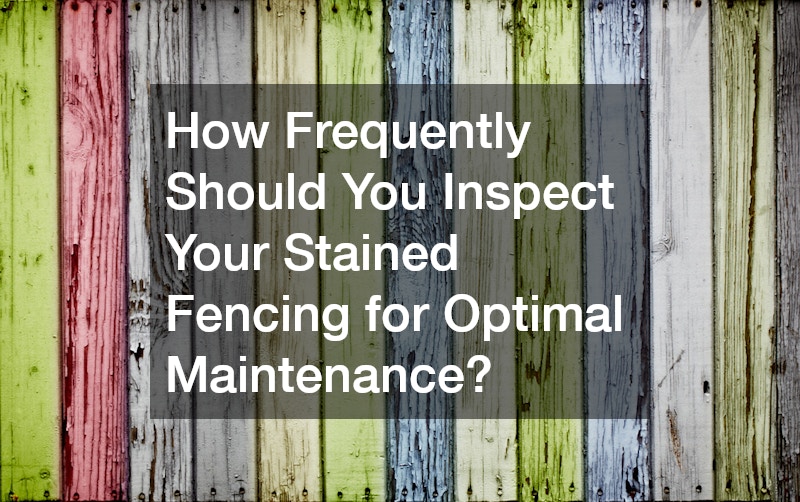Stained fencing is a popular choice for homeowners due to its aesthetic appeal and protective qualities. However, maintaining its look and functionality requires consistent care and attention. This article explores the many facets of ensuring the longevity of your coated fencing, from understanding the influence of weather to scheduling inspections and identifying common issues. By comprehensively addressing all these aspects, homeowners can keep their coated fencing in prime condition, enhancing both their property’s value and appearance. Whether you’re a DIY enthusiast or prefer professional services, this guide provides valuable insights and actionable tips for maintaining your coated fencing.
Understanding the Impact of Weather on Stained Fencing

Weather conditions play a significant role in the wear and tear of stained fencing. Rain, sun, snow, and wind all have different effects on the wood and the stain itself. For instance, prolonged exposure to sunlight can cause the stain to fade and the wood to dry out and crack, while excessive moisture from rain or snow can lead to rot and mildew.
Gate installation services often advise clients on choosing the best materials and stains that are more resistant to weather fluctuations. These services can ensure that your fencing is not only optimally positioned but also protected from the elements. High-quality stains and sealants can extend the life of your fence by creating a barrier against UV rays and moisture.
Regular maintenance, including cleaning and re-staining, becomes even more crucial in regions where the weather is particularly harsh. Extreme temperatures, whether hot or cold, can exacerbate existing issues or create new ones, making routine care essential. Local fence companies can offer valuable advice and services tailored to your specific climate, ensuring that your coated fencing remains durable and aesthetically pleasing throughout the year. By adapting your maintenance schedule to weather patterns, you can enhance the longevity and performance of your fence.
Recommended Inspection Frequency
Regular inspections are vital for maintaining the integrity of stained fencing. Most experts recommend inspecting your fence at least twice a year, typically in the spring and fall. These biannual inspections allow you to identify any damage or wear that may have occurred over the past months, enabling you to address issues before they escalate.
Local fence companies often offer inspection services as part of their maintenance packages. They can help identify problems that might not be immediately obvious to the untrained eye. For instance, minor cracks or areas where the stain has begun to wear off can be early signs of more significant issues.
Additionally, consider scheduling inspections after severe weather events, such as heavy storms or high winds. Extreme weather can exacerbate existing issues or cause new damage, so it’s essential to assess the fence’s condition promptly. By staying vigilant and proactive, you can ensure that minor damages are promptly repaired, maintaining the fence’s functionality and aesthetic appeal over time.
Spring and Fall Inspections: What to Look For
Spring and fall are ideal times for conducting thorough inspections of your coated fencing. During these periods, you should look for signs of mildew, rot, and insect infestations. Moisture levels tend to be higher in these seasons, making it easier to spot areas where water has caused damage.
A privacy fence contractor can provide valuable insights into what to look for during these inspections. They can help homeowners identify subtle signs of wear and tear that might otherwise go unnoticed. Cracks, peels, and discoloration are among the common issues that should be addressed immediately to prevent more extensive damage.
Stained fencing can also suffer from structural issues over time. During your inspections, check for loose or broken boards and ensure that the fence posts are firmly anchored in the ground. Additionally, inspect for any signs of shifting or leaning, which may indicate foundational problems. Addressing these problems promptly can prevent accidents, maintain the structural integrity of your fence, and ensure its longevity.
Identifying Common Issues During Inspections

Identifying common issues during inspections can save homeowners time and money in the long run. One of the most prevalent problems with coated fencing is the gradual wearing off of the stain. This can lead to the wood being exposed to the elements, causing further damage such as cracking, rotting, and discoloration.
A fence installation company can help repair or replace damaged sections of fencing. By relying on professional services, homeowners can ensure that repairs are done correctly and that the fence is treated with high-quality products to prevent future issues. Inspecting for common problems such as loose nails, warping, and insect damage is essential.
Another common issue is the growth of mildew and mold, especially in areas with high humidity. Regular cleaning and proper ventilation can help mitigate this problem. Ensuring that the fence is well-sealed can also prevent moisture from penetrating the wood, reducing the risk of mildew growth. Additionally, inspecting for signs of insect infestation, such as termites or ants, can prevent long-term structural damage. Addressing these issues promptly will help maintain the integrity and appearance of your coated fencing.
How to Inspect Stained Fencing: A Step-by-Step Guide
Inspecting stained fencing requires a systematic approach to ensure all potential issues are identified. Start by visually scanning the entire fence to look for obvious signs of wear, such as peeling stains, discoloration, or visible cracks. Pay special attention to areas that are in direct contact with soil or those exposed to extreme weather conditions.
Use a screwdriver or similar tool to test the wood’s softness, particularly at the base of the fence posts and along the bottom rail. Soft or spongy wood may indicate rot, which needs immediate attention. Checking the sturdiness of the fence is also crucial; ensure that all the posts are still firmly planted in the ground and that there are no loose panels.
Don’t forget to inspect the hardware, such as nails, screws, and hinges. Rusty or corroded hardware can weaken the structure of your fence and may need replacement. Additionally, look for any signs of mold or mildew growth, which can be indicative of moisture problems. For silt fences used in construction or erosion control, ensure they are intact and serve their purpose. Regular inspections with these steps can help maintain the longevity and appearance of your coated fencing, preventing minor issues from becoming major problems.
When to Reapply Stain or Sealant
Knowing when to reapply stain or sealant is key to maintaining coated fencing. Typically, stains need to be reapplied every two to three years, depending on the weather conditions and the type of stain used. Oil-based stains tend to last longer than water-based ones, but both will eventually wear down due to exposure.
Sealcoating is another option many homeowners consider to protect their fences. Sealants provide an additional layer of protection against moisture, UV rays, and mildew. Reapplying a sealant every one to two years can significantly prolong the life of your coated fencing and keep it looking fresh.
Pay close attention to the condition of the stain or sealant during your regular inspections. Signs that it’s time to reapply include faded color, visible wood grain, and water soaking into the wood instead of beading up on the surface. Additionally, monitor for peeling or chipping, as these indicate that the protective layer is failing. Keeping on top of these maintenance tasks will ensure your fence remains a beautiful and functional part of your landscape while safeguarding your investment against the elements.
The Role of Professional Inspections

While DIY inspections are essential, professional inspections play a significant role in maintaining stained fencing. Home building contractors often offer comprehensive inspection services that go beyond what a typical homeowner might notice. They can provide detailed assessments of your fence’s condition and recommend necessary repairs or treatments.
Professional inspectors have the tools and expertise to identify issues that might be missed during a casual inspection. They can test the moisture content of the wood, detect early signs of rot or insect infestation, and assess the durability of the existing stain or sealant. This professional input can be invaluable in preserving the longevity of your coated fencing.
In addition to identifying issues, professional inspections can provide peace of mind. Knowing that your fence has been evaluated by experts ensures that you’re taking the necessary steps to protect your investment. Regular professional inspections complement your maintenance efforts, ensuring the fence remains in top condition year-round. Moreover, they can offer tailored advice on preventive measures and adjustments based on the latest industry standards, enhancing the overall care of your fencing.
Preventive Measures to Extend Fence Life
Taking preventive measures is crucial to extending the life of stained fencing. One of the most effective steps is to apply a high-quality stain and sealant that offers protection against UV rays, moisture, and mildew. These products create a barrier that minimizes the impact of weather conditions on the wood.
Hiring a staining contractor to apply these treatments ensures that they are done correctly and uniformly. Professionals can also recommend the best products tailored to your specific climate and wood type. Regular reapplication, as mentioned earlier, keeps the protective layer intact and effective.
Additionally, controlling vegetation around the fence can prevent damage. Trees, bushes, and vines can hold moisture against the fence and lead to decay. Keeping the area around the fence clear and ensuring proper drainage can significantly reduce the risk of moisture-related issues, thereby extending the life of your coated fencing. Regularly trimming plants and ensuring that sprinklers do not hit the fence directly will further help in maintaining its condition and durability.
Cost Considerations for Fence Maintenance
Understanding the cost considerations of fence maintenance is essential for budgeting purposes. The initial investment in high-quality stain and sealant might be higher, but it pays off in the long run by extending the life of your fence and reducing the frequency of repairs. Regular maintenance can prevent costly replacements.
Painting contractors can provide estimates for re-staining and sealing services. These professionals can often obtain better prices on high-quality products and guarantee a uniform application. Additionally, the cost of professional inspections should be factored into your maintenance budget. Although it might seem like an added expense, it can save money by identifying and addressing issues early.
Local pressure washing services might also be needed periodically to clean the fence before re-staining or sealing. Pressure washing can effectively remove dirt, mildew, and old stains, preparing the surface for a new application. Factoring in these costs can help homeowners maintain their coated fencing without unexpected financial burdens. Remember, investing in proper maintenance not only preserves the fence’s appearance but also helps retain property value and curb appeal.
Keeping Your Stained Fencing in Top Condition

Keeping your stained fencing in top condition requires a combination of regular inspections, timely reapplication of stain or sealant, and preventive measures. Start by establishing a routine for visual inspections, especially after severe weather. Identifying and addressing issues promptly is key to preventing them from worsening.
Enlisting the help of local professionals, such as staining contractors and local pressure washing services, can ensure that your fence receives the best care. These experts have the tools and expertise to perform these tasks efficiently and effectively. Consistent care will keep your fence looking attractive and functioning well.
Lastly, always consider the environmental factors affecting your fence. Adapting your maintenance routine to your specific climate and conditions will yield the best results. Regularly checking for signs of wear and tear, such as peeling or discoloration, allows you to address potential problems early. By following these guidelines, your coated fencing can remain a beautiful and valuable asset to your property for many years.
Maintaining coated fencing requires a combination of regular inspections, timely repairs, and preventive measures. By understanding the impact of weather, conducting biannual inspections, and knowing what to look for, homeowners can stay ahead of potential issues. Hiring professionals for in-depth inspections and treatments can provide peace of mind and ensure high-quality results. Adopting these practices will not only enhance the appearance of your stained fencing but also extend its lifespan, making it a worthwhile investment for any homeowner. Consistent care and attention to detail will keep your fence in top condition, protecting your property and adding to its overall aesthetic appeal.



